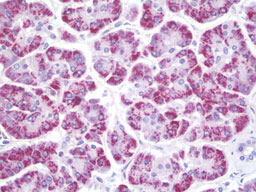GGT1 / GGT Antibody (aa1-226)
Rabbit Polyclonal Antibody
- SPECIFICATION
- CITATIONS
- PROTOCOLS
- BACKGROUND

Application
| WB, IHC-P |
|---|---|
| Primary Accession | P19440 |
| Reactivity | Human, Mouse |
| Host | Rabbit |
| Clonality | Polyclonal |
| Calculated MW | 61kDa |
| Dilution | IHC-P (10 µg/ml), WB (1:500-1:3000), |
| Gene ID | 2678 |
|---|---|
| Other Names | Gamma-glutamyltranspeptidase 1, GGT 1, 2.3.2.2, Gamma-glutamyltransferase 1, Glutathione hydrolase 1, 3.4.19.13, Leukotriene-C4 hydrolase, 3.4.19.14, CD224, Gamma-glutamyltranspeptidase 1 heavy chain, Gamma-glutamyltranspeptidase 1 light chain, GGT1, GGT |
| Target/Specificity | Human GGT1 / GGT |
| Reconstitution & Storage | Keep as concentrated solution. Aliquot and store at -20°C or below. Avoid multiple freeze-thaw cycles. |
| Precautions | GGT1 / GGT Antibody (aa1-226) is for research use only and not for use in diagnostic or therapeutic procedures. |
| Name | GGT1 |
|---|---|
| Synonyms | GGT |
| Function | Cleaves the gamma-glutamyl bond of extracellular glutathione (gamma-Glu-Cys-Gly), glutathione conjugates (such as maresin conjugate (13R)-S-glutathionyl-(14S)-hydroxy-(4Z,7Z,9E,11E,16Z,19Z)- docosahexaenoate, MCTR1) and other gamma-glutamyl compounds (such as leukotriene C4, LTC4) (PubMed:17924658, PubMed:21447318, PubMed:27791009). The metabolism of glutathione by GGT1 releases free glutamate and the dipeptide cysteinyl-glycine, which is hydrolyzed to cysteine and glycine by dipeptidases (PubMed:27791009). In the presence of high concentrations of dipeptides and some amino acids, can also catalyze a transpeptidation reaction, transferring the gamma-glutamyl moiety to an acceptor amino acid to form a new gamma-glutamyl compound (PubMed:17924658, PubMed:21447318, PubMed:7673200, PubMed:7759490, PubMed:8095045, PubMed:8827453). Contributes to cysteine homeostasis, glutathione homeostasis and in the conversion of the leukotriene LTC4 to LTD4. |
| Cellular Location | Cell membrane; Single-pass type II membrane protein {ECO:0000250|UniProtKB:P07314} |
| Tissue Location | Detected in fetal and adult kidney and liver, adult pancreas, stomach, intestine, placenta and lung. There are several other tissue-specific forms that arise from alternative promoter usage but that produce the same protein |
| Volume | 50 µl |

Thousands of laboratories across the world have published research that depended on the performance of antibodies from Abcepta to advance their research. Check out links to articles that cite our products in major peer-reviewed journals, organized by research category.
info@abcepta.com, and receive a free "I Love Antibodies" mug.
Provided below are standard protocols that you may find useful for product applications.
Background
Cleaves the gamma-glutamyl bond of extracellular glutathione (gamma-Glu-Cys-Gly), glutathione conjugates, and other gamma-glutamyl compounds. The metabolism of glutathione releases free glutamate and the dipeptide, cysteinyl-glycine, which is hydrolyzed to cysteine and glycine by dipeptidases. In the presence of high concentrations of dipeptides and some amino acids, can also catalyze a transpeptidation reaction, transferring the gamma-glutamyl moiety to an acceptor amino acid to form a new gamma-glutamyl compound. Initiates extracellular glutathione (GSH) breakdown, provides cells with a local cysteine supply and contributes to maintain intracellular GSH level. It is part of the cell antioxidant defense mechanism. Isoform 3 seems to be inactive.
References
Rajpert-De Meyts E.,et al.Proc. Natl. Acad. Sci. U.S.A. 85:8840-8844(1988).
Sakamuro D.,et al.Gene 73:1-9(1988).
Pitot H.C.,et al.Toxicol. Appl. Pharmacol. 97:23-34(1989).
Goodspeed D.C.,et al.Gene 76:1-9(1989).
Pawlak A.,et al.J. Biol. Chem. 265:3256-3262(1990).
If you have used an Abcepta product and would like to share how it has performed, please click on the "Submit Review" button and provide the requested information. Our staff will examine and post your review and contact you if needed.
If you have any additional inquiries please email technical services at tech@abcepta.com.













 Foundational characteristics of cancer include proliferation, angiogenesis, migration, evasion of apoptosis, and cellular immortality. Find key markers for these cellular processes and antibodies to detect them.
Foundational characteristics of cancer include proliferation, angiogenesis, migration, evasion of apoptosis, and cellular immortality. Find key markers for these cellular processes and antibodies to detect them. The SUMOplot™ Analysis Program predicts and scores sumoylation sites in your protein. SUMOylation is a post-translational modification involved in various cellular processes, such as nuclear-cytosolic transport, transcriptional regulation, apoptosis, protein stability, response to stress, and progression through the cell cycle.
The SUMOplot™ Analysis Program predicts and scores sumoylation sites in your protein. SUMOylation is a post-translational modification involved in various cellular processes, such as nuclear-cytosolic transport, transcriptional regulation, apoptosis, protein stability, response to stress, and progression through the cell cycle. The Autophagy Receptor Motif Plotter predicts and scores autophagy receptor binding sites in your protein. Identifying proteins connected to this pathway is critical to understanding the role of autophagy in physiological as well as pathological processes such as development, differentiation, neurodegenerative diseases, stress, infection, and cancer.
The Autophagy Receptor Motif Plotter predicts and scores autophagy receptor binding sites in your protein. Identifying proteins connected to this pathway is critical to understanding the role of autophagy in physiological as well as pathological processes such as development, differentiation, neurodegenerative diseases, stress, infection, and cancer.




